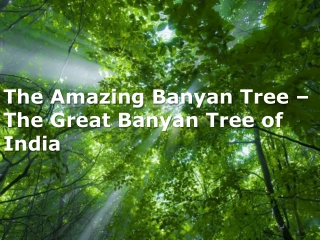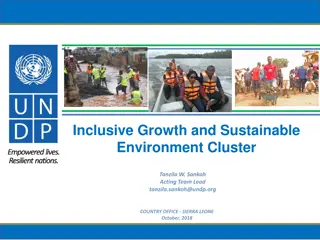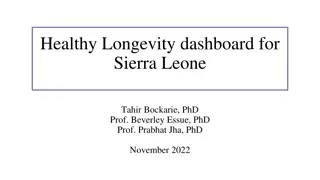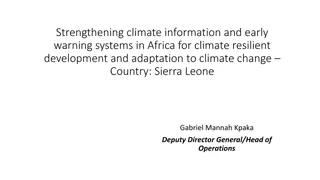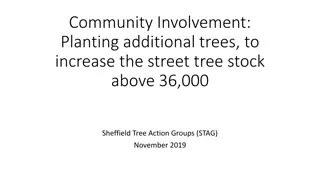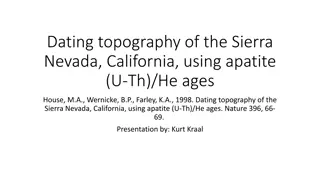Climate-Sensitive Tree Growth Modeling in Sierra Nevada Ecoregion
This project focuses on climate-sensitive individual tree growth models for the Sierra Nevada Ecoregion, aiming to provide accurate projections for forest adaptation and mitigation research. Collaborators and researchers utilize a sophisticated model structure to evaluate the impact of climate change on forest productivity. The project includes data fitting, modeling with linear mixed effects, and leveraging statistical software for forest growth simulation.
- Tree Growth Modeling
- Sierra Nevada Ecoregion
- Climate Change Impact
- Forest Productivity
- Linear Mixed Effects
Download Presentation

Please find below an Image/Link to download the presentation.
The content on the website is provided AS IS for your information and personal use only. It may not be sold, licensed, or shared on other websites without obtaining consent from the author. Download presentation by click this link. If you encounter any issues during the download, it is possible that the publisher has removed the file from their server.
E N D
Presentation Transcript
Climate Sensitive Individual Tree Growth Models for the Sierra Nevada Ecoregion: FVS-WESSIN TIM ROBARDS UNIVERSITY OF CALIFORNIA, BERKELEY CAL. DEPT. OF FORESTRY & FIRE PROTECTION, FIRE & RESOURCES ASSESSMENT PROGRAM
Collaborators Prof. Greg Biging, UC Berkeley Prof. John Battles, UC Berkeley Prof. Kevin O Hara, UC Berkeley Dr. Martin Ritchie, USDA Forest Service, PSW Mr. Guido Franco, Cal. Energy Commission Dr. Adrian Das, USGS Dr. William Stewart, UC Berkeley Extension
Presentation Outline Objectives Model Structure Data Modeling Results Implementation in FVS Evaluation Projections
Objectives Climate-sensitive forest growth simulator Accurate projections for adaptation and mitigation research Use best available data Six species: PP, SP, IC, DF, WF, RF Component of bi-annual climate change report Evaluate climate change impacts to forest productivity Mortality FVS modified variant Use available add-ons (FFE, pests) Take advantage of work already done (volume, imputation) Work with LMS or FVS carbon add-on for carbon projects
General Model Structure PBAL ln(dbh+1) = + + + + + [ln(GR)] E ln(dbh) (dbh) CR b b b b b 0 1 2 3 4 + + + PRECIP SL[sin(ASP)] TEMP b + SL+ SL[cos(ASP)] SL ln(ELEV+1) + b b b b b 5 6 7 8 + 9 10 SL ln(ELEV+1) cos(ASP) b 11 2 + + SL ln(ELEV+1) sin(ASP) SL ELEV b b 12 13 + 2 2 + + SL ELEV cos(AS P) SL ELEV sin(ASP) b b 14 15 + + + + 2 ELEV ELEV Albrx Albry b b b b e e 16 17 18 19 ik
Data Fit data No. of Diameter Increments 5,465 4,639 622 31,807 397 3,232 254 1,955 Years Covered (approx.) 1965-1980 1961-1998 1958-1988 1964-1987 No. of Diameter Remeas. No. of Height Increments No. of Height Remeas. No. of Plots No. of Trees Data Source NCStem NCPlot DolphMC DolphRF 105 0 2,436 2,991 1,417 1,296 0 3,725 4,436 3,564 39,741 284 44,025 150 0 0 Climate data PRISM Monthly 4x4 km grid Evaluation data
Modeling Linear mixed effects model Random: temporal, spatial Fixed: everything else R statistical software LME4 library (Bates 2007) GRID Graphics Equivalence library (Robinson 2007) Bakuzis matrix library (modified from Johnson (2007)) Criteria AIC Parameter significance (topography exception) Residuals
Results: Common Variables DBH THT CR PBAL Index Latitude
Results: Climate & Topography Climate Topography Winter Precip (10/12) Full specification (11/12) Winter Temp (10/12) WF height (ELEV) Many seasonal variables
Climate Variables 2.5 Only red fir growth entirely negative to temperature increases 2.0 Height Growth Multiplier Species, Season, Degree C Ponderosa pine, winter, Max 10 Ponderosa pine, spring, Max 5 Ponderosa pine, summer, Max 10 Sugar pine, winter, Min 10 Sugar pine, spring, Min 5 Incense-cedar, winter, Min 5 Incense-cedar, spring, Max 5 Douglas-fir, spring, Max 5 Douglas-fir, summer, Min 10 White fir, annual, Max 5 Red fir, winter, Max 10 1.5 More precipitation => more growth 1.0 Degree-day variables generally better than straight temperature 0.5 0 100 200 300 Degree Days Height Growth
PP Ht growth 0.4 Height Growth Multiplier Topography Slope, Aspect 0 Mid, N Mid, E Mid, S Mid, W Steep, N Steep, E Steep, S Steep, W 0.3 Stage and Salas (2007) formulation highly adaptable 0.2 0.1 Requires wide range of data 4000 6000 8000 Elevation (feet) Requires high tolerance for insignificant parameter estimates DF Diam. growth 12 10 Diameter Growth Multiplier Slope, Aspect 0 Mid, N Mid, E Mid, S Mid, W Steep, N Steep, E Steep, S Steep, W 8 6 4 2 2000 3000 4000 5000 6000 Elevation (feet)
Implementation in FVS Source Code from USDA Forest Service, Forest Management Service Center, Ft Collins, CO Lahey-Fujitsu Express ver. 7.1 Fortran Compiler Additional input file for climate data Annual time steps, maximum of 80 Height and diameter growth models for 6 species No changes to outputs YEAR PRE_W PRE_P PRE_S PRE_WP PRE_PS MAXT5D MAXT5D_W MAXT5D_P MAXT5D_S MINT5D_W 1 10600 5739 7640 16339 6503 365 151 92 122 31 2 12189 2801 11030 14990 3904 365 151 92 122 3 12138 1363 4730 13500 1835 365 151 92 122 4 8022 3801 0470 11823 3848 365 151 92 122 31 5 13785 2507 9070 16291 3413 365 151 92 122 31 6 8199 5864 2960 14063 6160 365 151 92 122 31 7 10522 3045 2710 13567 3316 365 151 92 122 31 8 4300 2692 2140 6992 2906 365 151 92 122 9 11346 4333 8900 15679 5223 365 151 92 122 31
Evaluation Model behavior evaluated using modified and reduced Bakuzis Matrix Forest Types: PP, MC, DF, WF, RF 10 x 10 spacing to 20 years in Conifers (Ritchie 2008) PCT and no PCT Flat ground, NE and SW aspects (30% slope) Equivalence test using regression method (Robinson 2007) 559 diameter, 167 height measurements 25% Reject null hypothesis that model and data different
Douglas-fir, Flat Ground, No PCT Climate Curves Height-Dbh Bakuzis Matrix 140 140 120 120 height 100 100 Leary's Triangular Form, Reduced 80 80 60 60 version 2.0 40 40 20 40 60 80 100 5 10 15 20 25 Sukachev Effect Reineke LEGEND Climate Scenario 400 400 stems 300 300 Average DryCold DryHot Hot WetCold WetHot 200 200 100 100 20 40 60 80 100 5 10 15 20 25 qmd Yield Curves Eichorn's Rule Yield-Density Effect 15000 15000 15000 volume 10000 10000 10000 5000 5000 5000 0 0 0 20 40 60 80 100 40 60 80 100 120 140 100 200 300 400 age height stems
Douglas-fir, SW Aspect, No PCT Climate Curves Height-Dbh Bakuzis Matrix 150 150 height Leary's Triangular Form, Reduced 100 100 50 50 version 2.0 20 40 60 80 100 10 20 30 40 Sukachev Effect Reineke LEGEND Climate Scenario 400 400 stems 300 300 Average DryCold DryHot Hot WetCold WetHot 200 200 100 100 20 40 60 80 100 10 20 30 40 qmd Yield Curves Eichorn's Rule Yield-Density Effect 25000 25000 25000 20000 20000 20000 volume 15000 15000 15000 10000 10000 10000 5000 5000 5000 0 0 0 20 40 60 80 100 50 100 150 100 200 300 400 age height stems
Projections 100-year projections Downscaled climate (Scripps Institute, UCSD) A2: CO2 850ppm max; self-reliance; population increases B1: CO2 550 ppm max; global solutions; population plateaus 4 GCMs Elevation transect (Tahoe National Forest) Other models in common area (Shasta County) Climate sequestration project LaTour State Forest (Southern Cascades) Westcarb Project Statewide Assessment?
Douglas-fir Stand, TNF, A2 14000 13000 Total Cubic Foot Volume per Acre GC Model PCM1 GFDL CRM3 CCSM FVS FVSAVG 12000 11000 10000 9000 1950 2000 2050 2100 Year
Douglas-fir Stand, TNF, B1 14000 13000 Total Cubic Foot Volume per Acre 12000 GC Model PCM1 GFDL CRM3 CCSM FVS FVSAVG 11000 10000 9000 1950 2000 2050 2100 Year
Questions/Comments Tim Robards tim.robards@fire.ca.gov 916.445.5342


